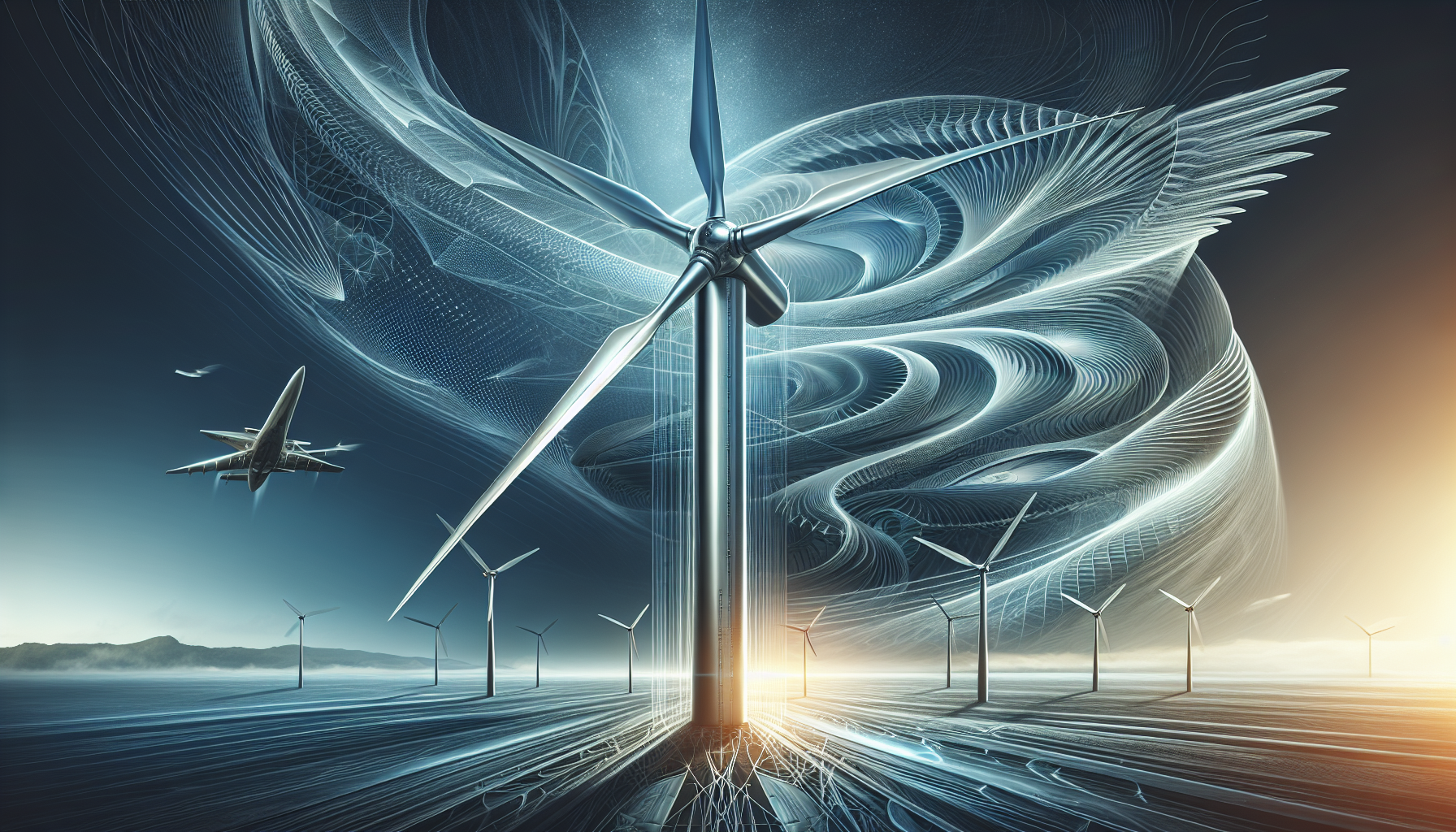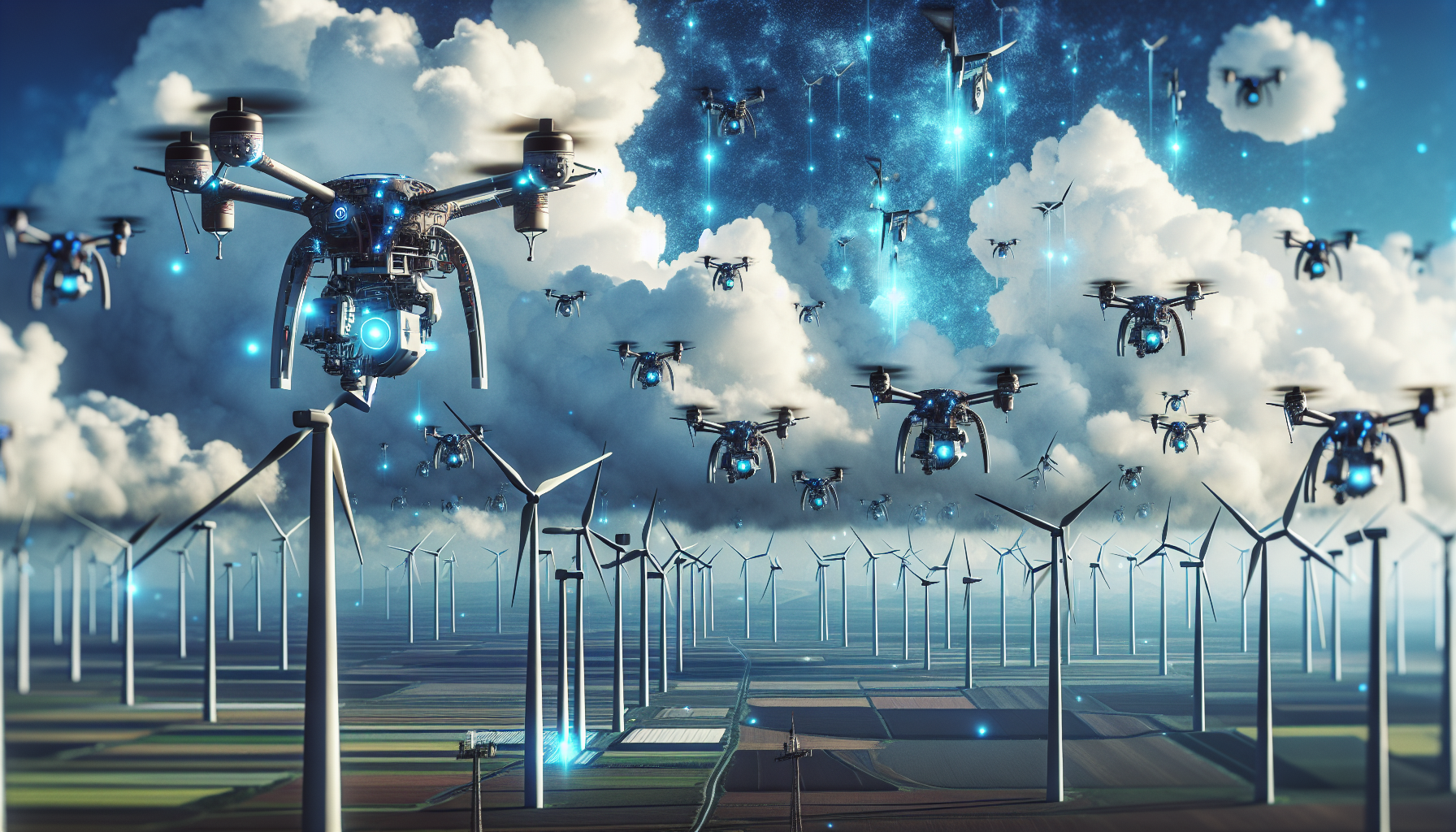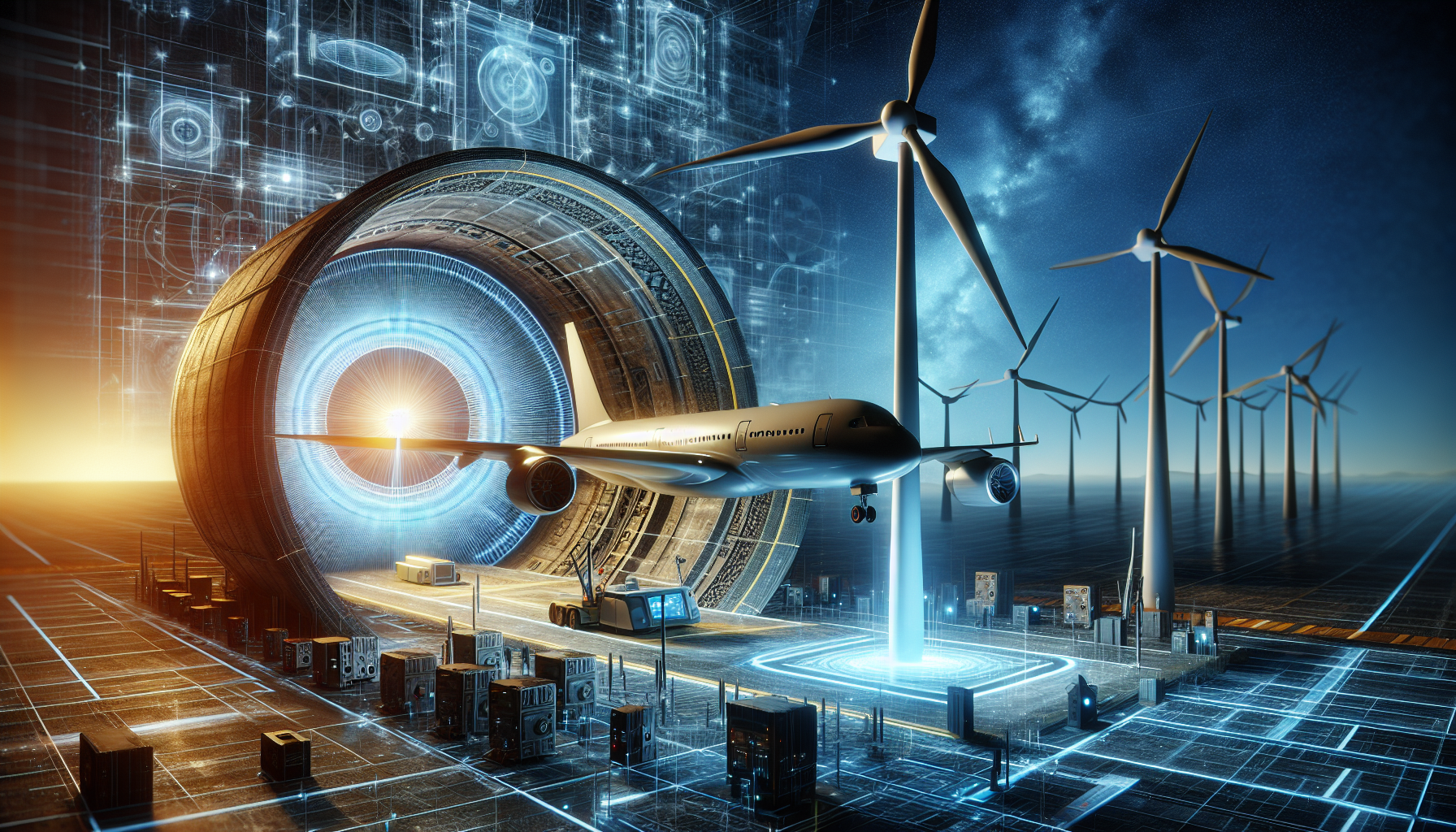Top Trends in Aerospace and Wind Energy: Revolutionizing Sustainable Technology
What are the transformative impacts of aerospace technology on wind energy? This article investigates how aerospace-derived materials, design, and technology are elevating wind power efficiency and sustainability. Brace for an exploration of the aerospace and wind energy convergence transforming renewable energy.
Key Takeaways
- Aerospace advancements, including sophisticated control systems, computational fluid dynamics, and advanced materials like carbon fiber, are being cross-applied to wind turbines, improving aerodynamics, efficiency, and durability while supporting sustainable practices through recyclability and the circular economy.
- Nondestructive Testing (NDT) techniques such as ultrasonic testing and radiographic testing are being enhanced and applied in aerospace and wind energy sectors to ensure the safety and reliability of equipment without causing damage, supporting quality control from production to field operations.
- Additive manufacturing is revolutionizing both aerospace and wind energy by enabling the rapid, cost-efficient, and precise production of complex components, while also playing a key role in sustainability through waste reduction and environmentally friendly production methods.
Harnessing the Skies: The Convergence of Aerospace and Wind Power
 The fusion of aerospace technology and wind power is a testament to the power of interdisciplinary collaboration. The field of wind power is benefiting from the advancements that have traditionally been confined to the aerospace sector, particularly in the areas of flight and space exploration. In recent years, the use of aerospace technology has enabled the wind power industry to make significant strides in terms of efficiency, reliability, and overall effectiveness. This synergistic relationship between the two fields has opened up new avenues for innovation and technological progress, which are paving the way for a more sustainable and energy-efficient future. Modern control systems, informed by aerospace innovations, are fine-tuning wind turbine operations. These technological marvels can optimize real-time wind variations, ensuring every gust counts.
The fusion of aerospace technology and wind power is a testament to the power of interdisciplinary collaboration. The field of wind power is benefiting from the advancements that have traditionally been confined to the aerospace sector, particularly in the areas of flight and space exploration. In recent years, the use of aerospace technology has enabled the wind power industry to make significant strides in terms of efficiency, reliability, and overall effectiveness. This synergistic relationship between the two fields has opened up new avenues for innovation and technological progress, which are paving the way for a more sustainable and energy-efficient future. Modern control systems, informed by aerospace innovations, are fine-tuning wind turbine operations. These technological marvels can optimize real-time wind variations, ensuring every gust counts.
The wind industry has embraced advanced computational fluid dynamics software, a product of aerospace innovation, to maximize aerodynamic efficiency in wind turbine designs. This breakthrough has led to the creation of wind turbines with aerospace features like winglets, which reduce drag and improve lift. With the use of aerospace-derived design optimization techniques, blades that perform more effectively across various wind conditions are now a reality. The integration of new technologies such as 3D printing, robotics, advanced materials, the Internet of Things, and smart manufacturing is further driving innovation and efficiency in sectors where both aerospace and wind energy convergence is evident, highlighting the importance of innovation in addressing sustainability and environmental concerns, improving supply chain visibility, and meeting changing consumer needs.
No discussion of aerospace’s contribution to wind power would be complete without recognizing the role of advanced materials. Aerospace has been instrumental in the development of lighter and more resilient composite materials. These materials have translated into more efficient wind turbine blades, marking a significant stride in harnessing wind power.
Advanced Materials in Flight and Turbines
 Diving deeper into the realm of materials science, one cannot overlook the impact of carbon fiber composites. These advanced materials have significantly reduced aircraft weight, leading to increased fuel efficiency and reduced emissions in the aerospace industry. Beyond aerospace, these materials are now being used to manufacture wind turbine blades, making them lighter and more durable.
Diving deeper into the realm of materials science, one cannot overlook the impact of carbon fiber composites. These advanced materials have significantly reduced aircraft weight, leading to increased fuel efficiency and reduced emissions in the aerospace industry. Beyond aerospace, these materials are now being used to manufacture wind turbine blades, making them lighter and more durable.
The incorporation of carbon fiber into wind turbine blades has not only improved their performance but also made them easier to recycle. This is a significant step towards sustainable practices such as the circular economy. The use of advanced materials and technologies has led to:
- A reduction in the cost of wind power
- Lighter and longer turbine blades
- Improved performance
- Increased power generation efficiency
Aerodynamics and Efficiency
 In harnessing the power of wind, optimizing turbine efficiency is paramount. Aerospace engineering strategies are now being applied to enhance the aerodynamic profiles of wind turbines, leading to increased energy capture. This has been made possible by leveraging the aerospace sector’s advanced aerodynamic modeling and simulation capabilities.
In harnessing the power of wind, optimizing turbine efficiency is paramount. Aerospace engineering strategies are now being applied to enhance the aerodynamic profiles of wind turbines, leading to increased energy capture. This has been made possible by leveraging the aerospace sector’s advanced aerodynamic modeling and simulation capabilities.
By applying these capabilities to the design and efficiency improvement of wind turbines, we have seen a significant boost in the productivity and overall efficiency of wind power generation. This cross-pollination of knowledge and technology demonstrates the vast potential of combining the expertise of these industries.
Remote Sensing and Monitoring
 The convergence of aerospace and wind power technologies also extends to remote sensing and monitoring. Drones, equipped with an array of sensors including:
The convergence of aerospace and wind power technologies also extends to remote sensing and monitoring. Drones, equipped with an array of sensors including:
- thermal
- ultrasonic
- magnetic
- radiographic
Each of the aforementioned sensors, have enhanced remote sensing capabilities in wind farms where deployed..
Such technological advancements not only increase productivity but also ensure worker safety. For instance, drones like the Elios 3 have significantly mitigated risk by removing the need for inspectors to enter some confined spaces, allowing for visual data collection indoors.
This seamless integration of technology is reshaping the way we monitor and maintain wind energy infrastructure.
Innovations in Nondestructive Testing (NDT) for Aerospace and Wind Energy
 Nondestructive Testing (NDT) is another area where aerospace and wind power sectors intersect. Innovations in this field are enhancing the safety and reliability of equipment in both industries as aerospace and wind energy converge. For instance, advancements in phased array ultrasonic testing (UT) have reduced inspection times. They also improve the detection of small defects in aerospace components. Additionally, electromagnetic testing, particularly eddy current, is another innovative NDT method in use. This method measures the strength of electrical currents in a magnetic field around a material. It helps determine the material’s properties and identify defects or imperfections.
Nondestructive Testing (NDT) is another area where aerospace and wind power sectors intersect. Innovations in this field are enhancing the safety and reliability of equipment in both industries as aerospace and wind energy converge. For instance, advancements in phased array ultrasonic testing (UT) have reduced inspection times. They also improve the detection of small defects in aerospace components. Additionally, electromagnetic testing, particularly eddy current, is another innovative NDT method in use. This method measures the strength of electrical currents in a magnetic field around a material. It helps determine the material’s properties and identify defects or imperfections.
Radiographic NDT Testing, which employs radiation from a radioactive isotope or X-ray generator, allows for the identification of internal defects without damaging the component. This is particularly important in the context of composite materials analysis, where NDT methods such as ultrasonic testing and liquid penetrant testing are critically employed. This ensures material properties and integrity are maintained without inflicting damage, supporting quality control in both the aerospace and wind energy sectors.
But the innovation doesn’t stop there. Advanced robotic scanning systems equipped to perform both pulse echo and through-transmission ultrasonic C-scan inspections are crucial in evaluating large and complex aerospace components. This drives efficiency in the NDT processes, paving the way for more reliable and robust systems.
Ensuring Integrity from the Factory Floor to the Field
In a world where product integrity is paramount, NDT systems are playing an instrumental role. Aerospace manufacturers employ customized NDT systems for in-house testing during the manufacturing process. The same NDT techniques used during production are adapted for in-field inspections, ensuring the ongoing integrity of aerospace equipment.
Through the use of NDT techniques from production to in-field inspections, manufacturers are able to prevent potential equipment failures and prolong the operational lifespan of industrial assets. This integrity, from the factory floor to the field, is a testament to the power of these innovative testing methodologies.
NDT Techniques in Composite Analysis
As we delve deeper into the world of NDT, it’s clear that certain techniques are more suited to analyzing composite materials. These materials, found in aerospace and wind turbine structures, pose unique inspection needs, leading to the evolution of specialized NDT methods such as:
- Ultrasonic testing
- Thermography
- X-ray and gamma-ray imaging
- Acoustic emission testing
- Shearography
These methods allow for accurate and reliable inspection of composite materials, ensuring their structural integrity and safety.
Acoustic emission testing is a prime example. This technique detects defects in composites by analyzing bursts of acoustic energy released by material imperfections. Moreover, innovative sensors like the FlawExplorer are pivotal in post-production and in-field inspections of composite materials, showcasing how technology is aiding in maintaining the highest standards of quality control.
Smart Factories: AI and Machine Learning in Production Processes
The advent of the Fourth Industrial Revolution has seen the rise of smart factories, where traditional production processes are being transformed by AI and machine learning. These technologies significantly enhance the production process, operational efficiency, and responsiveness to consumer needs, driving productivity to unprecedented levels.
Advanced manufacturing technologies that are revolutionizing production capabilities and efficiency in the manufacturing industry, as opposed to traditional manufacturing methods, include:
- 3D printing
- Artificial intelligence-based decision-making systems
- AI-driven predictive maintenance, which minimizes unplanned shutdowns in manufacturing operations
- AI in conjunction with computer vision, which enhances end-of-line quality control in manufacturing.
The implementation of private 5G networks aids in facilitating high-quality remote collaborations, supporting the deployment of autonomous systems, and improving overall productivity. Additionally, tools that convert raw data for data visualization and business intelligence applications contribute to better operational understanding and improved manufacturing processes.
Optimizing Supply Chain Visibility
In the world of smart factories, cloud computing and the Industrial Internet of Things (IIoT) play crucial roles in optimizing supply chain visibility. Manufacturers use cloud computing to host IT infrastructure on remote servers. These servers store, manage, and process data and applications. This hosting is essential for improving supply chain transparency and responsiveness.
Platforms like Ridge’s API connect all components of a distributed cloud infrastructure. This benefits multi-site manufacturing companies by providing reliable, low-latency connectivity to the cloud in diverse locations, thereby optimizing supply chain management.
The IIoT, in particular, fosters a more transparent and controllable supply chain by integrating interconnected sensors, devices, and instruments throughout the manufacturing process.
Predictive Maintenance on the Rise
The rise of predictive maintenance in smart factories is a testament to the power of data-driven decision-making. Predictive maintenance is a method of monitoring equipment to predict maintenance needs based on data and analysis, reducing maintenance costs and enhancing equipment efficiency.
Real-time machine data analysis enables companies to schedule proactive maintenance, minimize downtime, and boost operational efficiency. Moreover, drones perform inspections with greater frequency and precision, identifying issues earlier and providing significant ROI through reduced downtime and the avoidance of extensive scaffolding for indoor inspections.
This combination of data analysis and drone technology is transforming the way we maintain and optimize our industrial assets.
The Role of Additive Manufacturing in Aerospace and Wind Energy
Additive manufacturing, or 3D printing, has emerged as a game-changer in the aerospace and wind energy sectors. From companies like Xact Metal advancing aerospace manufacturing with 3D metal printing solutions, to Nematx pushing the boundaries by printing high-performance polymers, the revolution is well underway.
The intricate parts produced through additive manufacturing necessitate custom Nondestructive Testing (NDT) solutions to ensure their integrity. This reflects the technology’s key role in advanced aerospace applications and underscores how additive manufacturing is not just about creating parts, but also ensuring their quality and durability.
But the potential of additive manufacturing goes beyond just aerospace. The technology is also making waves in the wind energy sector, where it’s enabling the rapid manufacturing, cost savings, and high precision of turbine components. This highlights the versatility of additive manufacturing and its potential to transform a wide range of industries.
From Prototyping to Production
Additive manufacturing has broadened its role from merely speeding up rapid prototyping to enabling the full-scale production of finalized aerospace components. Notably, this includes the GE Aero LEAP fuel nozzle and the GE Catalyst turboprop engine. Moreover, the advancements in additive manufacturing have enhanced the grain structure quality of materials. These now match those of wrought materials and permit the creation of complex parts with internal structures. Traditional methods cannot produce these structures.
Furthermore, digital services empower additive manufacturing to rapidly cost various designs. Consequently, this speeds up the manufacturing process and enhances flexibility in engineering designs. Significantly, this transition from prototyping to production represents a crucial milestone in the additive manufacturing journey.
Customization Meets Sustainability
Innovation in additive manufacturing is also contributing to sustainability. This technology enables manufacturers to create products that are tailored to specific needs while simultaneously reducing environmental impact and improving resource efficiency. This intersection of customization and sustainability is a testament to the transformative power of advanced manufacturing technologies and manufacturing innovation.
In an era where sustainability is more important than ever, the ability to customize products while minimizing environmental impact is a significant advantage. It is this unique combination of benefits that makes additive manufacturing a critical component of future manufacturing strategies.
Renewable Energy Sources: Wind Power’s Growth Supported by Aerospace
The growth of wind power as a key source of renewable energy is being supported by aerospace advancements. Government support, like President Biden’s executive order to begin the construction of large-scale wind farms, is indicative of the growing importance of wind power in our energy mix. However, the journey to widespread adoption of wind power is not without its challenges.
The permitting of wind farms can be a lengthy process, but efforts are underway to speed up governmental approval despite resistance from groups like fishers. Despite these hurdles, offshore wind power installations make up 10% of new installations, showing growth in this sector. However, the need for increased public support and awareness of wind energy’s benefits is clear. Public support for wind power in the United States has declined from 75% in 2020 to 62% in 2021.
On a positive note, companies are reducing the carbon footprint of manufacturing facilities and products. They achieve this by using sustainable materials and green energy sources, such as wind power and nuclear power plants, to power operations. In fact, Acciona plans to build a wind blade recycling plant in Spain by 2025. This project will advance sustainability efforts within the wind industry.
Advancements in Offshore Wind Energy
The development of advanced offshore wind turbines is a prime example of how aerospace technology is driving the growth of wind power. The GE Haliade-X, for instance, utilizes responsive control systems derived from aerospace technology to thrive in marine environments.
The aerodynamic blades of the GE Haliade-X are optimized using aerospace technology, enabling greater energy capture and efficiency. The integration of aerospace technology in offshore wind energy paves the way for more robust and efficient large-scale wind farms.
Reducing Environmental Impact
In the quest for a sustainable future, reducing the environmental impact of wind energy is paramount. Aerospace technologies contribute to the sustainable use of materials in wind power projects through the process of valorization.
Valorization of wind turbine components significantly reduces the environmental impact, including greenhouse gas emissions. For instance, the carbon footprint of glass fibers can be lowered by 66% and carbon fibers by 95%. This is a testament to the potential of aerospace and wind power convergence in leading the way towards a greener planet.
Virtual Reality (VR) and Augmented Reality (AR) Training Synergies
In the realm of training and skill development, Virtual Reality (VR) and Augmented Reality (AR) are making a mark. These technologies are being utilized for immersive training simulations, allowing employees to learn complex tasks and procedures without the need for physical equipment.
Through the simulation of real-world scenarios, VR and AR enable workers to apply learned skills directly on the job. This effectively bridges the gap between theoretical learning and practical application, enhancing the overall training experience and efficiency.
Future-Proofing with Collaborative Robots (Cobots)
As we look towards the future, collaborative robots (cobots) stand out as a game-changer in the aerospace and wind energy sectors. Cobots offer several benefits, including:
- Significantly increasing efficiency and productivity
- Working alongside human operators
- Handling repetitive tasks
- Allowing humans to focus on more strategic and complex work
The adoption of cobots in manufacturing leads to reduced risks of human error and injuries, while also creating opportunities for greater product precision and customization. These collaborative machines, combined with human ingenuity, are set to redefine the future of manufacturing.
Circular Economy: Towards Sustainable Manufacturing Practices
The adoption of circular economy practices in wind energy manufacturing is another crucial trend. The concept involves strategies like reducing waste, extending product life cycles, and reusing and recycling materials to create second-generation products.
Research and development efforts focus on recycling wind turbine blade materials like fiberglass and carbon fiber. These materials are typically difficult to separate and recycle. Additionally, the inception of smart factories significantly advances the movement towards a low-carbon society. They do this by addressing climate change challenges.
Innovations in wind turbine design allow components to be easily broken down for use in subsequent applications. This facilitates the circular economy. For instance, the recycling facility Waste2Fiber will recycle composite materials from wind turbine blades. It transforms them into secondary raw materials with high added value. This marks a significant stride towards sustainable manufacturing practices.
Summary
The convergence of aerospace and wind power technologies is a shining example of how interdisciplinary collaboration can spark innovation. From harnessing the skies to the rise of smart factories, the synergies between these sectors are revolutionizing sustainable technology. As we move forward, it’s clear that this union will continue to fuel the growth of renewable energy sources and shape the future of sustainable manufacturing. Let’s continue to explore, innovate, and harness the power of synergy for a sustainable and prosperous future.
Frequently Asked Questions
What is the role of aerospace technology in wind power generation?
Aerospace technology plays a crucial role in advancing wind power generation through the development of lighter and more resilient materials, optimization of aerodynamics, and the use of drones for improved remote sensing capabilities in wind farms. This has significantly contributed to the progress of the wind power sector.
How is additive manufacturing revolutionizing aerospace and wind energy sectors?
Additive manufacturing, or 3D printing, is revolutionizing the aerospace and wind energy sectors by enabling rapid manufacturing, cost savings, high precision, and sustainability through customized products and reduced environmental impact. It has expanded from rapid prototyping to full-scale production of finalized aerospace components, marking a significant advancement in these industries.
How are Virtual Reality (VR) and Augmented Reality (AR) being used for training in the aerospace and wind power sectors?
Virtual Reality (VR) and Augmented Reality (AR) used for immersive training simulations in aerospace and wind power sectors, provide employees with the opportunity to learn complex tasks and procedures without physical equipment. This innovation allows rapid skill development directly on the job.
What are collaborative robots (cobots) and how are they used in the aerospace and wind power sectors?
Now, collaborative robots, called cobots, work alongside human operators as designed. They increase efficiency and productivity in manufacturing by handling repetitive tasks. Meanwhile, humans can focus on more strategic work. This technology reduces the risk of human error and injuries. It also enables greater product precision and customization. Thus, cobots are highly beneficial for sectors like aerospace and wind power.
How are circular economy practices being implemented in wind energy manufacturing?
Circular economy practices in wind energy manufacturing involve reducing waste. They extend product life cycles and recycle materials to create second-generation products. Meanwhile, innovations in wind turbine design enable easy component breakdown for use in subsequent applications. This fosters a circular economy approach in the industry.


